Great Mortgages. The Right Insurance. Expert Advice.
How economists and markets are reacting to a surprisingly hot CPI reading

The Globe and Mail – May 2023
Canada’s annual inflation rate ticked up to 4.4% in April, as higher shelter costs contributed to the first acceleration in the consumer price index in 11 months. The reading surprised the Street, which was looking for a further easing in the rate of inflation after it hit a peak of 8.1% last June.
Analysts polled by Reuters had expected annual inflation rate to edge down to 4.1% from 4.3% in March. Month-over-month, the consumer price index was up 0.7%, higher than the forecast 0.4% gain.
It was the first time since June 2022 that the annual inflation reading came in hotter than economists were expecting, according to National Bank Financial.
Expressed at an annualized rate, the three-month change in core inflation – excluding food and energy – was 4.2 per cent in April, up from 3.1 per cent in March.
The Canadian dollar spiked about two-tenths of a cent on the inflation report, while the Canadian 2-year bond yield – which is particularly sensitive to changes in central bank policy – rose about 10 basis points from prior to the data, to 3.89%.
Interest rate probabilities based on trading in swaps markets have now completely priced out Bank of Canada rate cuts this year. Prior to the data, they were giving about even odds of a 25 basis point cut and no rate moves at all by the end of this year.
Market positioning, however, also suggests traders see only modest odds that the bank will be hiking rates any further this year.
Here’s how money markets were pricing in further moves in the Bank of Canada overnight rate just prior to the 830 am ET data, according to Refinitiv Eikon data. The current Bank of Canada overnight rate is 4.5%. While the bank moves in quarter point increments, credit market implied rates fluctuate more fluidly and are constantly changing.
And here’s how this market position shifted aft

And here’s how this market position shifted after the inflation data hit.

Economists are also cautioning that rate cuts are beginning to look increasingly unlikely for this year. Here’s how they are reacting to the inflation report:
Royce Mendes, managing director & head of macro strategy at Desjardins Capital Markets
The slowdown in Canadian inflation is looking like it might have been a false dawn. … Both food and energy price growth eclipsed our forecasts for April. Excluding food and energy, prices were up 0.3% in seasonally-adjusted terms. …
Both of the Bank of Canada’s core measures accelerated in three-month annualized terms. The pace of trim now stands at 3.7%, while median is running at 3.8%, up from 3.3% and 3.7%, respectively. The newly minted core services excluding shelter metric remained roughly unchanged in three-month annualized terms at 4.5%. All of those remain well above the Bank of Canada’s 2% target.
As a result, the central bank will need to remain single minded when thinking about the stance of monetary policy. The fact that core measures of inflation remained elevated in April will be disconcerting for policymakers. Expect upcoming communications to remain hawkish and focused on bringing inflation to heel, leaving the door open to further rate increases. That said, data can be volatile, and today’s print won’t seal the deal on further tightening.
Stephen Brown, deputy chief North America economist, Capital Economics
A step backward. The renewed acceleration in the monthly changes in CPI-trim and CPI-median in April, combined with the recent rapid turnaround in the housing market, leaves us doubting our view that the Bank of Canada will be ready to cut interest rates as soon as October. …
The big disappointment is that the monthly changes in the CPI-trim and CPI-median measures of core inflation accelerated to 0.4%, from an average of 0.3% in March. Granted, that left the average three-month annualized rate at 3.7%, no higher than it was two months earlier, and the annual rates of both declined to an average of 4.2%, from 4.5%. But with Governor Tiff Macklem recently stressing that getting inflation down from 3% (where it is likely to be by the summer) to 2% will be the hard part, the April CPI data mean we still can’t take further interest rate hikes off the table and present a clear risk to our current forecast that the Bank will be ready to cut interest rates by October.
Jay Zhao-Murray, forex analyst, Monex Canada (a commercial foreign exchange specialist)
While stronger inflation for all items will be a less-than-welcome sight for the Bank of Canada’s top officials, the fact that price pressures have also risen in the metrics that they’ve highlighted as their preferred measures of core makes today’s report considerably worse. These measures—the 3-month annualized averages of CPI-median and CPI-trim—rose from 3.6% to 4.0% and 3.3% to 3.7%, respectively. As the Bank’s recent communications have placed an explicit focus on the upside risks to inflation, expressed worries about core inflation becoming stuck above 3%, and left the door open to future hikes if warranted by the data, we believe that markets are underpricing the risk of an additional insurance hike on June 7th.
Currently, the market-implied odds of a June hike sit at 34%, repriced up from 17% just prior to the report. Today’s CPI report, which was the final piece of high-impact data ahead of the next BoC decision, compounds the evidence we received earlier this month to suggest that the Canadian economy is heating back up. For instance, job growth was twice as strong as economists had anticipated, while the housing market appears to have bottomed, with housing starts, building permits, home prices and sales volumes all surging.
Looking deeper into the report, we see that almost all major components rose faster than the pace consistent with 2% inflation. Even the two weakest components, recreation, education, and reading (+0.2% MoM) and alcohol, tobacco, and cannabis (+0.2% MoM), merely tracked in line with that pace; none were weaker. The single greatest contributor to inflation was gasoline (+6.3%), a notoriously volatile series, but even after stripping out its effects, prices rose by 0.5% in April, which would annualize to 6.2% if maintained over 12 consecutive months. At the risk of understating the facts, this is not consistent with the Bank’s 2% inflation target. The rise in gasoline prices wasn’t even the only reason for the 1.5% increase in transportation costs, as the cost of operating a vehicle jumped by 2.9% in April. …
In a global context, the latest increase in headline and core inflation metrics will draw the attention of investors and traders as it is the first time this has happened within G10 economies for some time. Furthermore, it has occurred in Canada where interest rates are the joint-third highest among G10 economies, the central bank was one of the first to call and end to its hiking cycle, the transmission of monetary policy is deemed to be fairly quick given the domestic housing market’s high leverage ratios, and the headline inflation rate is the lowest outside of Switzerland and Japan. While this definitely plays into the hands of those analysts suggesting that inflation is likely to remain structurally above 2% given the shocks to the global economy and those asserting that further loosening in the labour market is required for inflation to fall from 4% back to target, we think it is too soon to make any clear connection. However, the signs for the BoC are definitely concerning. Given the breadth of inflation pressures, the uptick in their preferred measures of the momentum in core inflation, and evidence that the housing market is bottoming out and the labour market is still showing signs of strength, the Bank of Canada may be forced to deliver an insurance rate hike at their June meeting.
Leslie Preston, managing eirector & senior economist, TD Economics
Headline inflation took a breather on it’s trek down the mountain in April thanks to surging gasoline prices. We expect the pause will be temporary and inflation will resume heading lower in the months ahead. As outlined in our March forecast, we expect core inflation to continue to decelerate below 3% y/y in the second half of the year, as does the Bank of Canada.
Cooler inflation for demand-sensitive services inflation, or “supercore” was the most encouraging development of the report, even though it was somewhat offset by hotter inflation for goods. This reinforces the challenge Governor Macklem has talked about in bringing inflation all the way back to 2%. This suggests that the BoC needs to remain vigilant to inflation pressures, and may need to hike again if momentum in the domestic economy does not cool as expected.
Matthieu Arseneau and Alexandra Ducharme, economists at National Bank Financial
While April’s data is disappointing, there is still good news for the coming months. Gasoline prices are falling so far in May, which should contribute to a large moderation in annual inflation next month especially as favorable base effects occur in May and June. Indeed, the months of high inflation following the start of the war in Ukraine will be removed from the calculations, and the negative base effect will disappear from the year-over-year changes. While this morning’s numbers will likely put the central bank on guard, it does not mean that interest rate hikes should be resumed right away. According to our current inflation forecast, real interest rates will be above 1.0% in June, the most restrictive rates in 15 years (chart). Such a restrictive monetary policy should be sufficient to significantly calm the Canadian economy in the coming quarters and, as a result, cool inflation.
Avery Shenfeld, managing director and chief economist of CIBC Capital Markets
Having been cut nearly in half since last June, Canada’s CPI accelerated by only a single tick in May, but the 4.4% print will still be a bit of an eyebrow raiser for those counting on steady progress. … Two year yields were higher after the release, as the risk of a return to rate hikes at the next MPR release can’t be ruled out, as staying on hold is now very dependent on seeing a slowdown in the labour market.
Robert Kavcic, senior economist, BMO Capital Markets
Wading through all the moving parts suggests underlying core inflation is settling in around 4%, which is clearly still too high for the Bank of Canada’s comfort. With policy rates on hold at 4.5%, that leaves us with slightly positive real overnight interest rates. But the ‘core’ question is…is that tight enough? Maybe, but we (and the BoC) will be watching how some of the more interest-sensitive sectors of the economy, and the job market, evolve in coming months.
Claire Fan, analyst, RBC
Inflation in Canada accelerated in April, but has still on balance been easing since peaking in summer 2022. Early signs that the lagged impact of higher interest rates are weighing on economic growth suggest underlying price pressures should continue to ease. The BoC is expected to stay on the sideline for the remainder of the year.



